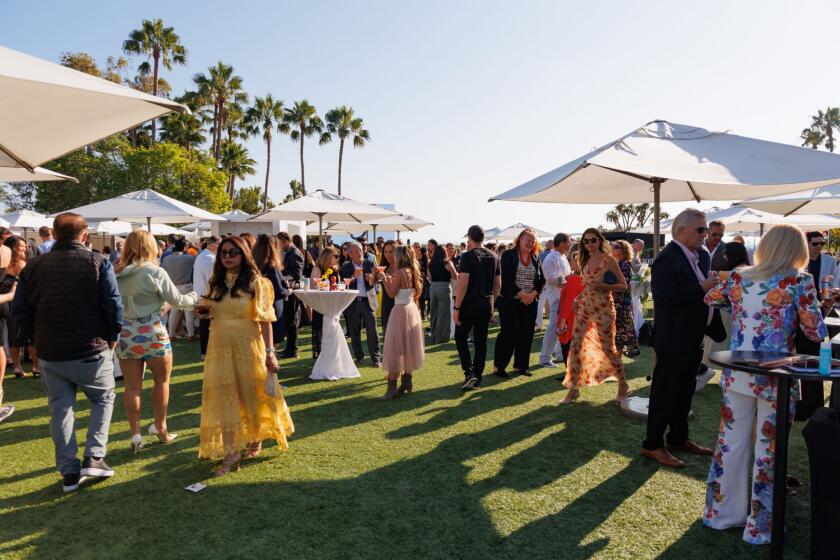Visiting family in friendly -- and chilly -- Slovakia
- Share via
Debbie Dignan
It was back in September of last year that my husband Jack and I
received an e-mail from our son James, in Biloxi, asking us if we
would like to join him, his wife and baby for the holidays in
Slovakia. Major James Dignan, U.S. Air Force, is a “Hurricane Hunter”
who pilots WC-130 airplanes into major storms.
His wife Simona is originally from Slovakia and has many relatives
there, including her parents and siblings. She assured us that we
would be most welcome at the family home in Poprad and she and James
would provide the airline tickets. They were also giving our daughter
Molly the same trip as a graduation gift because she was completing
her studies at Chapman University. This seemed like the proverbial
“offer you can’t refuse,” so we didn’t!
The first thing we did was to go online to see what we could learn
about this country, since we weren’t even clear as to its location in
Europe. We learned that it has existed as the Slovak Republic, having
separated from the former Czechoslovakia in 1993, and is bordered by
Austria, Hungary and Poland and what is now called the Czech
Republic.
We flew to Vienna, via Amsterdam, and were met by James and
Simona’s father, Fero, who had made the five-hour drive from Poprad
to meet us. We then located the Bahnhof, where we waited for Molly to
arrive on a train from Frankfurt. (James was unable to get her on the
same flight.) A friend of James’, in Germany, had made a two-hour
trip to Frankfurt just to meet Molly’s plane and see that she got on
the correct train to Vienna. That was just the first example of
people there going to great lengths to make this a wonderful
experience for us.
After the long drive on icy roads back to Poprad, we were welcomed
by Simona and the baby, her mom Anna and her 13-year-old brother Fero
Jr. We were given an entire floor in their large home that they built
themselves. Anna is an orthodontist in Poprad, a town of 44,000,
nestled at the foot of the High Tatra Mountains. She has three other
dentists working for her, but because of the socialized health
insurance, incomes are far below what an orthodontist in the U.S. can
command.
We soon learned that food preparation during the holidays was a
high priority. A typical breakfast includes yogurt, bread, fresh
fruit, a selection of cheeses and sliced meat and tea. The main meal
occurs at midday and always features homemade soup, various sausages,
bread, possibly a venison stew, dumplings, potatoes, sauerkraut and
home-preserved fruit, which is grown in summer on their property.
The grand finale was a huge variety of “Kolachy,” pastries and
sweet, continually replenished throughout the day. Wherever we
visited relatives and friends, we were treated to meals with many
different dishes and were shown such cordiality in their homes. On
New Year’s Eve, the family was given a private dining room in the
Atrium Restaurant and Penzion in Poprad, which is owned by Anna’s
cousin, with a huge feast prepared by family and friends. The
fireworks that Fero Jr. set off rivaled those we see in professional
displays at home. A friend of his who belongs to a traveling dance
troupe entertained guests with a break dance routine.
The church we attended in Poprad was built in the 13th century and contains many wood carvings that date back several centuries. It is
believed that heating the church will cause damage to these wooden
statues. Therefore, those of us in attendance felt as if we ourselves
might have become statues of ice by the end of the mass, especially
when we were told it got down to 15 degrees below zero. (We later
found ourselves questioning this theory when we visited churches of
similar vintage in other towns where heat was turned on.)
Our hosts took us to visit a number of interesting towns. Levoca
was a medieval royal “free town” that was an important trading center
on the route between Hungary and Poland. St. Jakub’s church there
houses the largest wood-carved altar in the world. Somehow, this
altar was transported and displayed at the 1967 World’s Fair in
Montreal.
We also went to the site of the famous Spis Castle, one of the
largest in Europe. The village of Pribylina is comprised of early
settlers’ homes that had been relocated from all over the country.
Dressed in early Slovakian clothing, craftspeople demonstrate skills
of long ago. Another day was spent sledding in the High Tatra
Mountains -- cold but exhilarating!
We would enjoy going to Slovakia again, in the spring or summer,
when we could visit places that weren’t accessible because of the
weather. Accustomed to living in Southern California, we found
ourselves “climately challenged” on this trip!
* DEBBIE DIGNAN is a Costa Mesa resident.
All the latest on Orange County from Orange County.
Get our free TimesOC newsletter.
You may occasionally receive promotional content from the Daily Pilot.









